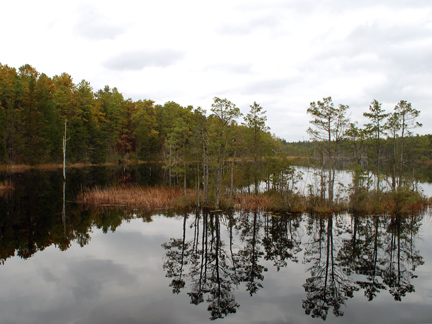Lake Oswego Road, Jenkin's Neck, NJ
Phone: (609) 296-1114
www.nj.gov/dep/parksandforests/parks/penn.html
NJ Department of Environmental Protection
From the parking area at Harrisville Lake, turn Right onto CR 679/Chatsworth Road. After 1.5 miles, bear Right onto CR 563/Greenbank Chatsworth Road. After 1.3 miles, turn Right onto Lake Oswego Road. Proceed 3.0 miles to a sand parking lot on the Right. DIRECTIONS FROM NEAREST HIGHWAY: From the intersection of Route 72 and Route 70 at Four Mile traffic circle, proceed East on Route 72. After 3.4 miles, turn Right on CR 563/Greenbank Chatsworth Road. After 12.2 miles, turn Left on Lake Oswego Road, which is not marked, but is before a canoe rental establishment. Continue 3.0 miles to the parking area on the Right at Oswego Lake. Map
Just North of the lake are the remains of an early Civilian Conservation Corp Camp. This was the segregated camp for African American enrollees in the 1930s. The ruins can be explored via the many sand roads running through the forest.
Just beyond the parking lot on Lake Oswego Road, a sand road forks to the left, traveling Northeast. This is called “Sooy Road” on some maps. The adventurous may care to make the 3.5 mile trek up this road (driving with 4wd is possible, but hiking is recommended) to visit the West Penn Pygmy Forest. Pygmy pines are a subspecies of pitch pine and grow only 6 feet at most. Their stunted growth is thought to be an adaptation for living in an area hit heavily by forest fires. Brochures describing this globally rare forest type will be available at Bass River State Forest Office.
 |
| Oswego Lake | Tony Geiger |
| |
| | Oswego Lake is a great “get-away” spot to picnic and experience the remote beauty and serenity of the Pine Barrens. White cedar and pitch pine forest provide a scenic background to the beauty of the lake. The best way to experience the lake is by kayak, but there are also miles of sand roads through Penn State Forest where a beginning or avid naturalist could spend hours exploring white cedar swamp, pitch pine forest, red maple swamp, and other habitats. The lake and surrounding forest offer the chance to encounter a plethora of wildlife, including snakes, lizards, turtles, birds, various insects and rare plants. 2010 marks the 100 year anniversary of Penn State Forest.
Plan to canoe or kayak the Oswego River a spring or summer morning when wildflowers and emergent vegetation are blooming, and wildlife is most varied and active. This is arguably the most pristine and scenic river in the Pine Barrens and an essential experience in order to have a true understanding of this unique landscape. Put in at Oswego Lake and haul out at Harrisville Lake, or for a more challenging paddle, do the opposite.
If snow is present, look for tracks from coyote, fox, deer, rabbit, squirrel, and even the occasional black bear. Local birds include Blue Jays, Cardinals, White-Throated Sparrows, American and Fish Crows, Carolina Chickadees, and White-Breasted Nuthatches. Scan the lake for Tundra Swans, Wood Ducks, Ring-Necked Ducks, Black Ducks and Pintail. Bald Eagle and Belted Kingfisher are also likely.
Beware of ticks and chiggers, which will emerge at the first sign of warming weather. Insect repellant is recommended, and sticking to the trails is a must. Spring migration, the emerging of spring wildflowers and the blossoming of hardwood trees such as, maples and sassafras, provide a show. Frogs are active in late spring. Check the water’s edge for sundews, pitcher plants, and lady slippers.
In summer, residents and visitors use the lake for picnicking, canoeing and kayaking. Red squirrels are not deterred by people and can be found frolicking around the area. Eastern Towhees, American Robins, Northern Cardinals, Carolina Wrens, Song and Chipping Sparrows, and Chickadees are a few of the most viewable birds. Great Blue Herons may be seen in the shallow water and Bald Eagles over the lake. Northern water snake, pine snakes, and even king snakes may also make a surprise visit.
Late summer into early fall is great for wildflower viewing, specifically species of wetland sedges, rushes and grasses. Migrating butterflies and dragonflies find this area attractive. Eastern Towhees favor the underbrush scattered around the picnic area. Watch for migrating raptors, such as Osprey, Bald Eagles, and Red-tailed Hawks over the lake. Late fall is quiet and serene, and a good time to have the lake to yourself.
|